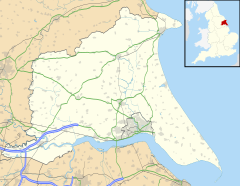world.wikisort.org - United_Kingdom
Hayton is a village and civil parish in the East Riding of Yorkshire, England. It is situated approximately 2 miles (3 km) south of the market town of Pocklington and 4.5 miles (7 km) north-west of the market town of Market Weighton. It lies on the A1079 road.

| Hayton | |
|---|---|
 St Martin’s Church, Hayton | |
 | |
 Hayton Location within the East Riding of Yorkshire | |
| Population | 360 (2011 census)[1] |
| OS grid reference | SE819457 |
| • London | 165 mi (266 km) S |
| Civil parish |
|
| Unitary authority |
|
| Ceremonial county |
|
| Region |
|
| Country | England |
| Sovereign state | United Kingdom |
| Post town | YORK |
| Postcode district | YO42 |
| Dialling code | 01759 |
| Police | Humberside |
| Fire | Humberside |
| Ambulance | Yorkshire |
| UK Parliament |
|
The parish includes Burnby together with the hamlet of Thorpe le Street. The parish covers an area of 1,729.333 hectares (4,273.27 acres),[2] According to the 2011 UK census and the parish had a population of 360,[1] an increase on the 2001 UK census figure of 317.[3] Although the civil parish is called "Hayton"[4] its parish council is called "Hayton and Burnby Parish Council".[5] On 1 April 1935 Burnby and Thorpe le Street parish was abolished and merged with Hayton.[6]
The church dedicated to St Martin was designated a Grade I listed building in 1967 and is now recorded in the National Heritage List for England, maintained by Historic England.[7]
In 1823 Hayton was a village and a civil parish in the Wapentake of Harthill. The ecclesiastical parish was Hayton-cum-Beilby, with the parish incumbent living under the patronage of the Dean of York. Population at the time was 177. Occupations included twelve farmers, a blacksmith, a wheelwright, a corn miller, a shoemaker, and the landlord of The White Horse public house.[8]
References
- UK Census (2011). "Local Area Report – Hayton Parish (1170211195)". Nomis. Office for National Statistics. Retrieved 19 February 2018.
- "2001 Census Area Profile" (PDF). East Riding of Yorkshire Council. 2004. Archived (PDF) from the original on 18 March 2012. Retrieved 8 February 2013.
- UK Census (2001). "Local Area Report – Hayton Parish (00FB066)". Nomis. Office for National Statistics. Retrieved 1 March 2020.
- "Hayton". Ordnance Survey. Retrieved 5 February 2021.
- "Home". Hayton and Burnby Parish Council. Retrieved 5 February 2021.
- "Relationships and changes Hayton CP/AP/Ch through time". A Vision of Britain through Time. Retrieved 5 February 2021.
- Historic England. "Church of St. Martin (1084144)". National Heritage List for England. Retrieved 12 August 2013.
- Baines, Edward (1823): History, Directory and Gazetteer of the County of York, p. 214
- Gazetteer – A–Z of Towns Villages and Hamlets. East Riding of Yorkshire Council. 2006. p. 6.
External links
Другой контент может иметь иную лицензию. Перед использованием материалов сайта WikiSort.org внимательно изучите правила лицензирования конкретных элементов наполнения сайта.
WikiSort.org - проект по пересортировке и дополнению контента Википедии